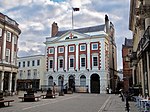Coney Street
Coney StreetStreets in York

Coney Street is a major shopping street in the city centre of York, in England. The street runs north-west from the junction of Spurriergate and Market Street, to St Helen's Square. New Street leads off the north-east side of the street, as does a snickelway leading to the Judge's Court hotel, while several snickelways lead from the south-west side down to the River Ouse, including Blanshard's Lane, and paths leading to City Screen.
Excerpt from the Wikipedia article Coney Street (License: CC BY-SA 3.0, Authors, Images).Coney Street
Coney Street, York Bishophill
Geographical coordinates (GPS) Address External links Nearby Places Show on map
Geographical coordinates (GPS)
| Latitude | Longitude |
|---|---|
| N 53.9592 ° | E -1.0841 ° |
Address
Coney Street
Coney Street
YO1 8ND York, Bishophill
England, United Kingdom
Open on Google Maps











